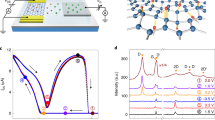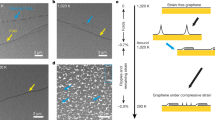Abstract
Acenes can be thought of as one-dimensional strips of graphene and they have the potential to be used in the next generation of electronic devices. However, because acenes larger than pentacene have been found to be unstable, it was generally accepted that they would not be particularly useful materials under normal conditions. Here, we show that, by using a physical vapour-transport method, platelet-shaped crystals of hexacene can be prepared from a monoketone precursor. These crystals are stable in the dark for a long period of time under ambient conditions. In the crystal, the molecules are arranged in herringbone arrays, quite similar to that observed for pentacene. A field-effect transistor made using a single crystal of hexacene displayed a hole mobility significantly higher than that of pentacene. This result suggests that it might be instructive to further explore the potential of other higher acenes.
This is a preview of subscription content, access via your institution
Access options
Subscribe to this journal
Receive 12 print issues and online access
$259.00 per year
only $21.58 per issue
Buy this article
- Purchase on Springer Link
- Instant access to full article PDF
Prices may be subject to local taxes which are calculated during checkout





Similar content being viewed by others
References
Bendikov, M., Wudl, F. & Perepichka, D. F. Tetrathiafulvalenes, oligoacenenes, and their buckminsterfullerene derivatives: the brick and mortar of organic electronics. Chem. Rev. 104, 4891–4946 (2004).
Bao, Z. & Locklin, J. (eds) Organic Field-Effect Transistors (CRC Press, 2007).
Anthony, J. E. The larger acenes: versatile organic semiconductors. Angew. Chem. Int. Ed. 47, 452–483 (2008).
Bendikov, M. et al. Oligoacenes: theoretical prediction of open-shell singlet diradical ground states. J. Am. Chem. Soc. 126, 7416–7417 (2004).
Aleshin, A. N., Lee, J. Y., Chu, S. W., Kim, J. S. & Park, Y. W. Mobility studies of field-effect transistor structures based on anthracene single crystals. Appl. Phys. Lett. 84, 5383–5385 (2004).
De Boer, R. W., Klapwijk, T. M. & Morpurgo, A. F. Field-effect transistors on tetracene single crystals. Appl. Phys. Lett. 83, 4345–4347 (2003).
Goldmann, C. et al. Hole mobility in organic single crystals measured by a ‘flip-crystal’ field-effect technique. J. Appl. Phys. 96, 2080–2086 (2004).
Marschalk, C. Linear hexacenes. Bull. Soc. Chim. Fr. 6, 1112–1121 (1939).
Clar, E. Aromatic hydrocarbons. XXIV. Hexacene, a green simple hydrocarbon. Ber. Dtsch. Chem. Ges. B 72B, 1817–1821 (1939).
Bailey, W. J. & Liao, C-W. Cyclic dienes. XI. New syntheses of hexacene and heptacene. Cyclic dienes. XI. New syntheses of hexacene and heptacene. J. Am. Chem. Soc. 77, 992–993 (1955).
Angliker, H., Rommel, E. & Wirz, J. Electronic spectra of hexacene in solution (ground state, triplet state, dication and dianion). Chem. Phys. Lett. 87, 208–212 (1982).
Champbell, R. B. & Robertson, J. M. The crystal structure of hexacene, and a revision of the crystallographic data for tetracene and pentacene. Acta Cryst. 15, 289–290 (1962).
Purushothaman, B., Parkin S. R. & Anthony, J. E. Synthesis and stability of soluble hexacenes. Org. Lett. 12, 2060–2063 (2010).
Kaur, I. et al. Substituent effects in pentacenes: gaining control over HOMO–LUMO gaps and photooxidative resistances. J. Am. Chem. Soc. 130, 16274–16286 (2008).
Kaur, I., Stein, N. N., Kopreski, R. P. & Miller, G. P. Exploiting substituent effects for the synthesis of a photooxidatively resistant heptacene derivative. J. Am. Chem. Soc. 131, 3424–3425 (2009).
Kaur, I., Jazdzyk, M., Stein, N. N., Prusevich, P. & Miller, G. P. Design, synthesis, and characterization of a persistent nonacene derivative. J. Am. Chem. Soc. 132, 1261–1263 (2010).
Purushothaman, B., Bruzek, M., Parkin, S. R., Miller, A. F. & Anthony, J. E. Synthesis and structural characterization of crystalline nonacenes. Angew. Chem. Int. Ed. 50, 7013–7017 (2011).
Mondal, R., Shah, B. K. & Neckers, D. C. Photogeneration of heptacene in a polymer matrix. J. Am. Chem. Soc. 128, 9612–9613 (2006).
Mondal, R., Adhikari, R. M., Shah, B. K. & Neckers D. C. Revisiting the stability of hexacenes. Org. Lett. 9, 2505–2508 (2007).
Tönshoff, C. & Bettinger, H. F. Photogeneration of octacene and nonacene. Angew. Chem. Int. Ed. 49, 4125–4128 (2010).
Mondal, R., Okharimenko, A. N., Shah, K. & Neckers, D. C. Photodecarbonylation of α-diketones: a mechanistic study of reactions leading to acenes. J. Phys. Chem. B 112, 11–15 (2008).
Yamada, H. et al. Photochemical synthesis of pentacene and its derivatives. Chem. Eur. J. 11, 6212–6220 (2005).
Chen, K. Y., Hsieh, H. H., Wu, C. C., Hwang, J. J. & Chow, T. J. A new type of soluble pentacene precursor for organic thin-film transistors. Chem. Commun. 1065–1067 (2007).
Chuang, T. H. et al. Photogeneration and thermal generation of pentacene from soluble precursors for OFET applications. Org. Lett. 10, 2869–2872 (2008).
Watanabe, M. et al. Solution-processed organic micro crystal transistor based on tetraceno[2,3-b]thiophene from a monoketone precursor. J. Mater. Chem. 21, 11317–11322 (2011).
Lai, C. H., Li, E., Chen, K. Y., Chow, T. J. & Chou, P. T. Theoretical investigation of cheletroptic decarbonylation reactions. J. Chem. Theor. Comput. 2, 1078–1084 (2006).
Davydov, A. S. The theory of molecular excitons. Sov. Phys. Usp. 7, 145–178 (1964).
Siebrand, W. & Zgierski, M. Z. in Springer Series in Solid-State Science Vol. 49 (eds Reineker, P., Haken, H. & Wolf, H. C.), Part V, 136–144 (Springer, 1983).
Miao, Q., Nguyen, T. Q., Someya, T., Blanchet, G. B. & Nuckolls, C. Synthesis, assembly, and thin film transistor of dihydrodiazapentacene: an isostructural motif for pentacene. J. Am. Chem. Soc. 125, 10284–10287 (2003).
Stevens, B., Perez, S. R. & Ors, J. A. Photoperoxidation of unsaturated organic molecules. XIV. O21Δg acceptor properties and reactivity. J. Am. Chem. Soc. 96, 6846–6850 (1974).
Mazur, M. & Blanchard, G. J. Photochemical and electrochemical oxidation reactions of surface-bound polycyclic aromatic hydrocarbons. J. Phys. Chem. B 108, 1038–1045 (2004).
Maliakal, A., Raghavachari, K., Katz, H., Chandross, E. & Siegrist, T. Photochemical stability of pentacene and a substituted pentacene in solution and in thin films. Chem. Mater. 16, 4980–4986 (2004).
Uda, M. Open counter for low energy electron detection. Jpn J. Appl. Phys. S24(4), 284–288 (1985).
Laudise, R. A., Klic, C., Simpkins, P. G. & Siegrist, T. Physical vapor growth of organic semiconductors. J. Cryst. Growth 187, 449–454 (1998).
Capelli, S. C., Albinati, A., Mason, S. A. & Willis, B. T. M. Molecular motion in crystalline naphthalene: analysis of multi-temperature X-ray and neutron diffraction data. J. Phys. Chem. A 110, 11695–11703 (2006).
Brock, C. P. & Dunitz, J. D. Temperature dependence of thermal motion in crystalline anthracene. Acta Crystallogr. C 46, 795–806 (1990).
Holmes, D., Kumaraswamy, S., Matzger, A. J. & Vollhardt, K. P. C. On the nature of nonplanarity in the [N]phenylenes. Chem. Eur. J. 5, 3399–3412 (1999).
Mattheus, C. C. et al. Polymorphism in pentacene. Acta Crystallogr. C 57, 939–941 (2001).
Kobayashi, S. et al. Control of carrier density by self-assembled monolayers in organic field-effect transistors. Nature Mater. 3, 317–322 (2004).
Yang, S. Y., Shin, K. & Park, C. E. The effect of gate-dielectric surface energy on pentacene morphology and organic field-effect transistor characteristics. Adv. Funct. Mater. 15, 1806–1814 (2005).
Onclin, S., Ravoo, B. J. & Reinhoudt, D. N. Engineering silicon oxide surfaces using self-assembled monolayers. Angew. Chem. Int. Ed. 44, 6282–6304 (2005).
Takeya, J. et al. Field-induced charge transport at the surface of pentacene single crystals: a method to study charge dynamics of two-dimensional electron systems in organic crystals. J. Appl. Phys. 94, 5800–5804 (2003).
Yang, H. et al. Conducting AFM and 2D GIXD studies on pentacene thin films. J. Am. Chem. Soc. 127, 11542–11543 (2005).
Kitamura, M. & Arakawa, Y. Pentacene-based organic field-effect transistors. J. Phys. Condens. Matter 20, 184011 (2008).
Butko, V. Y., Chi, X., Lang, D. V. & Ramirez, A. P. Field-effect transistor on pentacene single crystal. Appl. Phys. Lett. 83, 4773–4775 (2003).
Roberson, L. B. et al. Pentacene disproportionation during sublimation for field-effect transistors. J. Am. Chem. Soc. 127, 3069–3075 (2005).
Reese, C., Chung, W. J., Ling, M. M., Roberts, M. & Bao, Z. High-performance microscale single-crystal transistors by lithography on an elastomer dielectric. Appl. Phys. Lett. 89, 202108 (2006).
Jurchescu, O. D., Popinciuc, M., Van Wees, B. J. & Palstra, T. M. Interface-controlled, high-mobility organic transistors. Adv. Mater. 19, 688–692 (2007).
Jurchescu, O. D., Baas, J. & Palstra, T. M. Effect of impurities on the mobility if single crystal pentacene. Appl. Phys. Lett. 84, 3061–3063 (2004).
Parisse, P., Passacantando, M., Picozzi, S. & Ottaviano, L. Conductivity of the thin film phase of pentacene. Org. Electron. 7, 403–409 (2006).
Acknowledgements
The authors thank D.-L.M. Tzou and M.-M. Chen (Academia Sinica) for measuring the CP-MAS 13C NMR spectrum. Computations were carried out using the computer facilities at the Academia Sinica Computing Center. This work was supported by the National Science Council and Academia Sinica in Taiwan.
Author information
Authors and Affiliations
Contributions
M.W. designed and performed the experiments and theoretical calculations. Y.J.C. measured and analysed the data. S.W.L. and M.M.I. designed the devices and analysed the data. T.H.C. and C.H.Y. fabricated the devices. K.G. carried out X-ray diffraction analysis on the crystals. M.W., Y.T.T. and T.S. co-wrote the paper. T.J.C. supervised the project.
Corresponding author
Ethics declarations
Competing interests
The authors declare no competing financial interests.
Supplementary information
Supplementary information
Supplementary information (PDF 3024 kb)
Supplementary information
Crystallographic data for hexacene using Cu radiation. (CIF 28 kb)
Supplementary information
Crystallographic data for hexacene using Mo radiation. (CIF 29 kb)
Rights and permissions
About this article
Cite this article
Watanabe, M., Chang, Y., Liu, SW. et al. The synthesis, crystal structure and charge-transport properties of hexacene. Nature Chem 4, 574–578 (2012). https://doi.org/10.1038/nchem.1381
Received:
Accepted:
Published:
Issue Date:
DOI: https://doi.org/10.1038/nchem.1381
This article is cited by
-
MOF-made polyacenes
Nature Synthesis (2023)
-
Synthesis of polyacene by using a metal–organic framework
Nature Synthesis (2023)
-
Preparative-scale synthesis of nonacene
Nature Communications (2022)
-
Synthesis of oligoacenes using precursors for evaluation of their electronic structures
Photochemical & Photobiological Sciences (2022)
-
Spin current distribution in antiferromagnetic zigzag graphene nanoribbons under transverse electric fields
Scientific Reports (2021)



